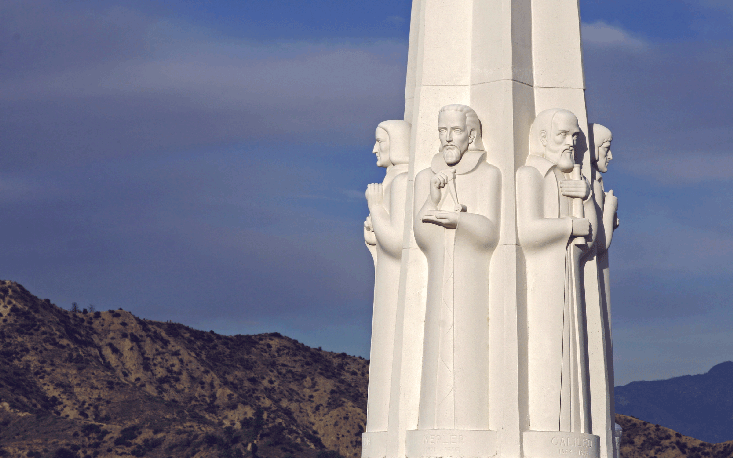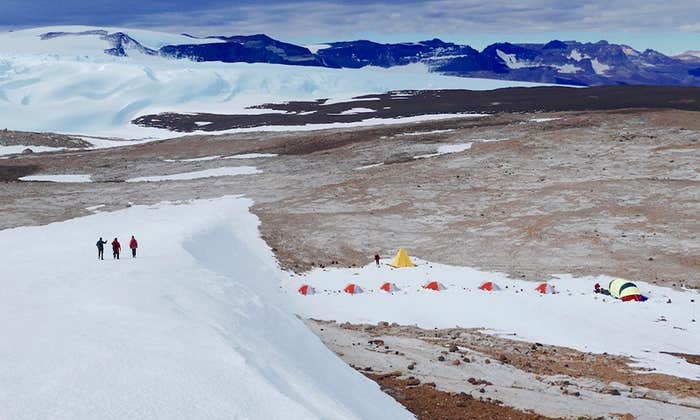Dr. Edwin C. Krupp has spent more than 40 years researching how ancient cultures worshipped and studied the parade of celestial lights—the movement of the sun, moon, planets, and stars—to make sense of seasonal cycles on Earth. An “archaeoastronomer,” who studies the early history of astronomy, Krupp has written five books and visited more than 1,900 historic and prehistoric sites associated with the sky.
From the ancient Egyptians, who built monuments aligned with the annual rising of the bright star Sirius, to the New World’s Incas, who constructed temples positioned to track the sun, people have been guided by the heavens, telling stories about the sky that not only brought a sense of order to their lives but ultimately led to the development of modern astronomy, Krupp notes.
Since 1974, Krupp has been director of the Griffith Observatory in Los Angeles. In 2004, he oversaw the $93 million renovation of the iconic structure. Today, the 75-year-old observatory features two public telescopes, each mounted inside a copper-clad dome.
Despite the modern tools of astronomy, people still see portents in the sky. In 1982, the solar system’s planets grouped together loosely on one side of the sun, which some doomsday prognosticators claimed would trigger a catastrophic phenomenon known as the Jupiter Effect. Griffith Observatory took the lead in reassuring the public that the Jupiter Effect would not trigger a great California earthquake, as some soothsayers had predicted.
Always animated and ready with a story, Krupp spoke to Nautilus from his Observatory office.
How did astronomy develop?
We are pattern-seeking creatures who use patterns to anticipate the future, understand the past, and tell stories about ourselves to make sense of the world. I think it’s fair to say that the deep origins of astronomy are in that recognition of those patterns in the sky that are locked to the Earth. Many traditional cultures were acutely aware of the seasonal comings and goings of food and other resources and they linked those critical changes to the appearance and disappearance of certain stars or groupings of stars. When do the rivers flood? When do the salmon run? When do the bison rut? Those are the things that mattered, and people saw the connections between them and the sky.

Why is storytelling so important in the development of astronomy?
It’s a tool for survival. The Egyptians told tales of the battles that the sun might be enduring as it moves across the sky. Of course the sun isn’t going through battles; it’s the Earth rotating on its axis as it moves in orbit around the sun that causes the apparent, relative movement of the sun. But even if you tell the wrong story, it may persist for thousand of years if it brings order to the behavior of the world around you.
What’s the connection between astronomy and math?
The path between math and science can be traced all the way back to Mesopotamia. I don’t think that’s very far back, actually, only about 4,000 to 5,000 years. In terms of human experience on the planet, that’s not very much. But math has a power for people that is far more expansive than simply what’s happening in the sky and how things overhead work.
Because math was a way to order the universe?
Certainly it was. But if you’re looking for the roots of mathematics, it has to begin with, “I’ve got sheep, how many?” “I’ve got a family. Is anyone missing?” So counting, numeration, and manipulation of numbers have got to be very archaic skills. We have lots of economic records from ancient Mesopotamia, and it would be easy to argue that the real power of mathematics in ancient Mesopotamia was business.
How did ancient cultures perceive light from the heavens?
Because sources of light are indicative of power, celestial objects were assigned a divine character. They become gods whose behavior bears watching because they are either a power source that affects things on Earth or they signal what’s taking place on Earth.
It was a real time of threat for the weak and young and infirm. If the sun doesn’t turn back and do what it does every year, the cosmos is in trouble.
Was there a type of celestial light that was most important to people in the Stone Age?
We don’t have enough evidence to say it was the stars first or the moon or sun. But certainly the stars were one of the most fundamental and simple things. It can be anything from a single star to the distinctive Pleiades cluster, or maybe a grouping like the Southern Cross. They were using the stars not to map the sky but as landmarks for the seasonal march of time. A particular star appears in the morning sky when the caterpillars are behaving a certain way or when the fish are active: They contrive a picture of the world that links the behavior of the sky, particularly the stars, to things that matter on Earth. This may well be the first way in which people linked the sky to the earth and its resources.
What role did the sun play in ancient cultures?
People were making elementary observations of the sun—variations in its height during the course of the day, its location at its highest point, and changes where it rises and it sets. Even nomadic people had this connection with the sun. Narratives were created and modeled on what the sun was doing. In California, the Chumash Indians had the notion that everything was at risk when you hit winter. It was a real time of threat for the weak and young and infirm. The notion develops that if the sun doesn’t turn back and do what it does every year, the cosmos is in trouble. Every year there was a sense of cosmological crisis at winter solstice. People knew the sun was headed south, they knew how far it would normally go. So they would undertake ritual activity to influence the outcome of what seemed to be going on in the cosmos and translate it into stories and activities that made very specific sense to them in their culture.
And the role of the moon?
The moon is a more complicated creature in the sky, but it does do some things that are very obvious and simple and useful. It races through the sky compared to the others, and as it does so it changes dramatically. People get this picture of the moon going through its monthly transformation and equate that with the female fertility cycle because the lengths of time are about the same. They also count the number of full moons, because the passage of time through the seasons is what’s important. People weren’t even that interested in how many days there are in a year. It was, where are we in the progress of the stars, where are we in the progress of the sun, how many moons have gone by?
Studying the Inca tradition, you said you had a remarkable revelation about the Pleiades constellation. Can you tell us about it?
The Pleiades were among the luminous gods depicted inside a temple at the heart of the Incan empire. The alignment of the temple was on the rising direction of the Pleiades. To archaeoastronomers, this seems very puzzling. We’re used to lining up stuff on the sun. So what’s going on? The answer for a long time has been, well, the Pleiades were an important seasonal signal. People talk about how many of the stars they see, how bright they appear to be, whether they are sharp, whether they are fuzzy. They make prognostications about their strategies for the coming year. It’s an item of discussion and consensus that leads to a community decision that is a life and death matter.
But here’s the interesting thing. There’s a very good anthropological study that examines what the Incas were learning from the Pleiades. It turns out what they were observing each year was the varying climatic conditions produced by the presence or absence of an El Niño, which creates high altitude cirrus clouds. These cirrus clouds are fundamentally invisible, but they do alter the appearance of things like stars in the sky, and the Pleiades are a very subtle thing to observe. Satellite data have demonstrated that the Incas were correctly observing what El Niño is doing from year to year! They’re making appropriate decisions based on average temperatures and rainfall! The fact the Pleiades were prominent to the Incas at the time of the conquest suggests they have been doing this for at least 500 years. They are still doing it in villages in Peru.
Did astronomy have a role beyond agriculture?
Yes, early studies of the sky provided stability and structure to social and political organizations. A perfect example of this is the emperor in ancient China, who was regarded as the primary intermediary between Earth and the divine force in heaven. The emperor is sacred, and that stabilized and protected the way that the Chinese culture allowed itself to be governed.
He performed alchemy, he was an astronomer who got royal support. His extraordinary achievements epitomized pre-telescopic astronomy.
Who are the founders of astronomy?
If we’re talking about ancient Greek and Mediterranean astronomy, Ptolemy epitomized that whole initiative in the second century. He consolidated the astronomical knowledge of his time, developed new and detailed methods of geometric calculation of celestial objects, and refined methods of pinpointing and predicting the position of the sun, moon, and planets. Another key character is the Greek astronomer Hipparchus from the second century B.C. He created a brightness scale for the stars, something we now take for granted. He systematically identified the location and brightness of stars just as they were beginning to be used to map the sky rather than just representing seasonal landmarks. We also credit Hipparchus as the first to recognize the phenomenon of prerecession, which is the wobbling of the Earth on its axis every 26,000 years. It may not seem very significant and it doesn’t affect everyday life. But back in antiquity when people knew that the sky seemed to turn daily, and there were objects that moved at other rates, and yet here was one more subtle movement of the sky. It was an extraordinary discovery.

In your book, Echoes of the Ancient Skies, you write that “our Greek ancestors invented scientific cosmology and by grappling with space, time, and the heavenly spheres they set us on the course that has lifted us off the Earth and carried us to worlds beyond our own.” So the Greeks’ knowledge was handed down to cultures centuries later?
Yes. The mechanism by which this occurred is at least partially understood thanks to the incredibly important Islamic transmission. You have these astonishing texts on astronomy in the Islamic world that wind up getting carried along the Silk Road and then into Spain, where you have a political climate that welcomes scientific and mathematical inspiration. Following the Islamic traditions, the astronomer Ulugh Beg in 1420 built an observatory in Samarkand [Uzbekistan]. One of the most important instruments at his observatory was a large arch, used to calculate midday. He used a meridian arc, among other instruments, to make the first star atlas, catalogue, and charts since Ptolemy.
When did the goals of astronomy begin to change?
Throughout the Middle Ages in Europe, the focus was on perfecting the calendar. You needed to know where you were in the year, and so you would put out a calendar that was based on the seasonal behavior of the sun and the cycles of the moon. The date of Easter was a profound driver in that the church operated as a main template for important dates of the year. Another driver is the Age of Exploration, which emerged in the 14th and 15th centuries. Once people were navigating great distances at sea, there was a greater urgency for a reliable instrument to orient you and provide your location. That problem didn’t get solved until the development of the mechanical clock, long after the beginning of the Age of Exploration. But all through that time people were trying. With the invention of the telescope in 1609, Galileo discovered the moons of Jupiter. People started wondering if they could use some of the new discoveries about the sky to keep track of the time.
Does one person stand out from the rest in carrying astronomy into the modern age?
It’s got to be Tycho Brahe [1546-1601], who became a scientist of all trades. He performed alchemy, he was an astronomer who got royal support—he was given an entire island where he built not one, but two observatories. His extraordinary achievements epitomized pre-telescopic astronomy. His observations shattered the preconceived notions about the character of the heavens. He discovered a “new star”—a supernova—in the sky when no new stars should be seen. He showed that comets were above Earth’s atmosphere, where bodies were thought to be immutable. These discoveries genuinely altered the perception of the nature of the cosmos. Then Kepler inherited, or rather, purloined, all these observations from Tycho and from those, Kepler managed to see that uniform circular motion of the planets, first promulgated by Ptolemy and the ancients Greeks, is not really what the game is.
What lessons can we learn from ancient astronomy?
The examination of antiquity creates a sense of how we got here and the values that enriched people’s lives and can enrich our own. If people are charmed by the sunrise, notice the phases of the moon, or have a chance to see the Northern Lights, those things enrich their emotional sensibility about themselves and the world. That to me is like art and music—the things we do to be grateful for the richness of being alive.
Ron Cowen is a freelance science writer in Silver Spring, Md., who specializes in astronomy and physics.






























